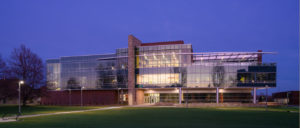A goofy poodle named Gus is making an immortal contribution to human and animal health. Gus belongs to Dr. Steve Dow and his wife, Robyn Elmslie, but stem cells from his skin will someday belong to the world.
“The lab is full of Gus cells right now. He’s everywhere,” says Dow, scratching the dog’s shaggy head.

Dow directs the Center for Immune and Regenerative Medicine at CSU’s C. Wayne McIlwraith Translational Medicine Institute. Dow’s team has adapted a new technology that reprograms adult cells into pluripotent stem cells, which can behave like embryonic stem cells.
“It takes only a small snippet of skin tissue, and with the right technology you can reprogram the cells to become immortal,” Dow says. “Then, those cells can be driven to become whatever cell type you want them to be – retinal cells, blood vessel cells, muscle cells, reproductive cells, white blood cells. They can be put into a patient to replace defective cells and treat many ailments, from arthritis to wound infections.”
Scientists don’t often speak in such terms, but Dow thinks the potential is “unlimited” in terms of replacing unhealthy tissues or reprogramming your own cells to become healthy again.
“It’s really the future of regenerative medicine,” Dow says. “And we think that dogs can play a big role in showing the safety of the cells, and their efficacy in treating spontaneous diseases. That’s a big step. The dog is a more realistic model than mice in terms of immune responses and the diseases dogs develop. The ultimate goal is to move from dogs to people. We’re a few years off from human trials, but it’s a powerful new technology, and as it matures it will transform medicine.”

TMI Roundtable
Dow and a few of his colleagues at the Translational Medicine Institute got together to “translate” what takes place in the building, which will celebrate its grand opening on May 6.
Kristen Browning-Blas: Dr. McIlwraith has defined “translational medicine” as “the use of basic laboratory research, preclinical research in vivo, and clinical examination that leads to patient success – with what we learn in animals often translating into improved medical treatment in humans.” What does “translational medicine” mean to you?
Terry Opgenorth: Biology is biology across the comparative spectrum of animals to humans. Like humans, horses eat, poop, run, jump, they have joints, they have bones, they have muscle. What you learn on one side translates to the other.
Dr. Valerie Johnson: It starts with an idea. We test a few things out in the lab and then we decide if it can safely be given to an animal. If that works, could it be moved into humans?
Dr. David Twedt: It can go the other way, too. Some things from human medicine have been adapted to veterinary medicine.
Dr. Dave Frisbie: There’s a classic ‘benchtop to bedside’ process in medical research. We’ve expanded it to ‘bench-top to barn to bedside.’
 Dr. Steven Dow: We develop cell-based therapies to treat a variety of diseases in animals and humans. For us, it means moving that from the lab into the clinic in a timely and efficient manner.
Dr. Steven Dow: We develop cell-based therapies to treat a variety of diseases in animals and humans. For us, it means moving that from the lab into the clinic in a timely and efficient manner.
Browning-Blas: From the theoretical to the practical?
Dow: Yeah, reducing it to reality, to practicality. Because we are doing research in companion animals with naturally occurring disease, it validates the results for human trials. There are closer similarities between humans and dogs than between humans and mice. If it works in dogs, it’s much more likely to work in humans.
John Kisiday, Ph.D.: I’m doing basic research to learn about the fundamentals of cells. I’m an engineer, so I think about how cells behave and ways to convince cells to rebuild tissue. I think about cell-based strategies for repairing tissue, and I look for ways to translate that into animals using engineering methods.
Browning-Blas: So you have a bad knee. How do you convince the cells to do what you want?
Kisiday: You look for the right formula to redirect the cells to do something they aren’t doing. You look for ways to convince them to do a certain job, and from there, to do it in a manner that works clinically. Then I can say to Laurie, ‘this is what I can do, and this is what I think you could do with it.’
Dr. Laurie Goodrich: Some of the most common things I see are joint disease, joint injuries, and broken bones. My goal is to get those to heal quickly before other complications occur. Hopefully, because the similarities between horses and people are so strong, what we learn from our equine clinical patients almost directly applies to humans as well. I work a lot with M.D.s who are seeing the same injuries in their patients as we are in horses. Our research feeds off one another.
Browning-Blas: It feels like this physical space expresses the big ideas within. How is the building going to contribute to the work?
Twedt: The architects did a great job of designing the space so people can talk and exchange ideas.
Dow: Yeah, you get people together and they start talking. That’s how it happens. Humans are still social animals. The café is probably the best meeting place of all. You’re relaxed, there’s food. You’ve got no agenda, you’re just trying to get lunch.
Johnson: John Kisiday is across the hall and he was looking at what I was doing, and he goes, ‘you should try this,’ and he gives me one of his three-decker flasks and shows me how to use it and put some cells on there. There are great little insights being around other people who are doing the same thing and having the chance to chat.
Browning-Blas: Serendipitous meetings yield insights that you wouldn’t have had otherwise. How will those insights benefit humans and animals?
Frisbie: We deal with the same problems, just different species. If we can solve the problem in one species, it can be applied to the other.
Opgenorth: Product development is our mission. Discoveries made by scientists in the labs at CSU are important. To make them impactful for patients, we need to turn them into a product or service that the patient experiences directly. For example, you’ve got a new cell therapy that repairs damage to the cartilage and joints, and we turn that into a cell-therapy product used to treat joint disease in animal and human patients.
Goodrich: When I started vet school, a wise man told me it takes 20 to 30 years for a good idea to get to market, and that has not changed very much. It’s almost worse now. That’s too long! When we begin with the end in mind and use the great minds we have here, from people like John on the basic science side, the radiologists on the imaging side, the translational scientists that help mold the idea and then put it into animals, and then work with the M.D.s who work with people, it hopefully will cut that time in several halves.
Twedt: In the continuing education world, it’s going to be significant. What we teach at the TMI isn’t learned in just four years of vet school. We are elevating veterinary medicine.
Browning-Blas: The people are the most important ingredient in the TMI, but what about the equipment and technology? Are we breaking boundaries there?
Dr. Chris Kawcak: For MRI, we’ve been constrained because the procedure takes so long. We couldn’t really afford to have horses under anesthesia for long. With the new MRI, the procedure is very fast, and we now have the capability to go directly from the MRI to the OR to treat the problem.
Browning-Blas: So what does “translational” mean in the context of diagnostic imaging?
Kawcak: It directly translates between species because diagnostic imaging is used clinically in veterinary and human patients, so if we can see on an MRI for instance, that one of Laurie’s therapies is effective, that translates over to the human side, because MRI is the diagnostic outcome of choice to see whether something is working or not.
If Laurie has a new cartilage replacement technique and they want to know if it’s working, you’ve got to be able to demonstrate using common diagnostic techniques like MRI, that you see improvement.
For two reasons: one is to make sure that it is something that is reasonable to continue to explore, but also from a regulatory standpoint. The FDA is going to want to see those outcome parameters, because those results will translate over to the human side. They want to show safety and efficacy, and one way they do that is through diagnostic imaging.
Browning-Blas: This is complicated stuff. What’s your elevator speech?
Lappin: We try to make sick animals well and improve the lives of their owners. We do that through making new tests to diagnose illnesses and new treatments – vaccines and immunotherapies – to lessen illness.
Opgenorth: We are looking for research outcomes that we can make into a product that has impact in veterinary or human medicine, either way.
Goodrich: I’m an equine surgeon half the time and a scientist half the time, so one drives the other for me. I take the biggest problems that I see in the clinic and research those in my lab. Then we take the best of what we find in the lab into clinical studies.
Twedt: Our goal is to change the paradigm of postgraduate learning.
Kawcak: We can use diagnostic imaging – X-ray, ultrasound, MRI, CT, PET imaging – to measure if biologics and translational therapies actually work.
That’s a long elevator ride.